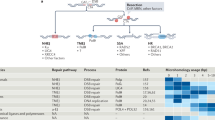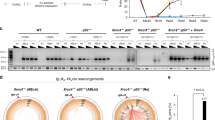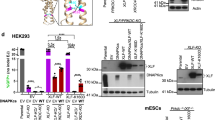Abstract
LKB1/STK11 is a tumor suppressor gene responsible for Peutz-Jeghers syndrome, an inherited cancer disorder associated with genome instability. The LKB1 protein functions in the regulation of cell proliferation, polarization and differentiation. Here, we suggest a role of LKB1 in non-homologous end joining (NHEJ), a major DNA double-strand break (DSB) repair pathway. LKB1 localized to DNA ends upon the generation of micro-irradiation and I-SceI endonuclease-induced DSBs. LKB1 inactivation either by RNA interference or by kinase-dead mutation compromised NHEJ-mediated DNA repair by suppressing the accumulation of BRM, a catalytic subunit of the SWI/SNF complex, at DSB sites, which promotes the recruitment of an essential NHEJ factor, KU70. AMPK2, a major substrate of LKB1 and a histone H2B kinase, was recruited to DSBs in an LKB1-dependent manner. AMPK2 depletion and a mutation of H2B that disrupted the AMPK2 phoshorylation site impaired KU70 and BRM recruitment to DSB sites. LKB1 depletion induced the formation of chromosome breaks and radials. These results suggest that LKB1-AMPK signaling controls NHEJ and contributes to genome stability.
This is a preview of subscription content, access via your institution
Access options
Subscribe to this journal
Receive 50 print issues and online access
$259.00 per year
only $5.18 per issue
Buy this article
- Purchase on Springer Link
- Instant access to full article PDF
Prices may be subject to local taxes which are calculated during checkout







Similar content being viewed by others
References
Richard F, Muleris M, Dutrillaux B . Chromosome instability in lymphocytes from patients affected by or genetically predisposed to colorectal cancer. Cancer Genet Cytogenet 1994; 73: 23–32.
Hemminki A, Markie D, Tomlinson I, Avizienyte E, Roth S, Loukola A et al. A serine/threonine kinase gene defective in Peutz-Jeghers syndrome. Nature 1998; 391: 184–187.
Sanchez-Cespedes M, Parrella P, Esteller M, Nomoto S, Trink B, Engles JM et al. Inactivation of LKB1/STK11 is a common event in adenocarcinomas of the lung. Cancer Res 2002; 62: 3659–3662.
Matsumoto S, Iwakawa R, Takahashi K, Kohno T, Nakanishi Y, Matsuno Y et al. Prevalence and specificity of LKB1 genetic alterations in lung cancers. Oncogene 2007; 26: 5911–5918.
Wingo SN, Gallardo TD, Akbay EA, Liang MC, Contreras CM, Boren T et al. Somatic LKB1 mutations promote cervical cancer progression. PLoS One 2009; 4: e5137.
Shackelford DB, Shaw RJ . The LKB1-AMPK pathway: metabolism and growth control in tumour suppression. Nat Rev Cancer 2009; 9: 563–575.
Roy BC, Kohno T, Iwakawa R, Moriguchi T, Kiyono T, Morishita K et al. Involvement of LKB1 in epithelial-mesenchymal transition (EMT) of human lung cancer cells. Lung Cancer 2010; 70: 136–145.
Bungard D, Fuerth BJ, Zeng PY, Faubert B, Maas NL, Viollet B et al. Signaling kinase AMPK activates stress-promoted transcription via histone H2B phosphorylation. Science 2010; 329: 1201–1205.
Marignani PA, Kanai F, Carpenter CL . LKB1 associates with Brg1 and is necessary for Brg1-induced growth arrest. J Biol Chem 2001; 276: 32415–32418.
Osley MA, Shen X . Altering nucleosomes during DNA double-strand break repair in yeast. Trends Genet 2006; 22: 671–677.
van Attikum H, Fritsch O, Gasser SM . Distinct roles for SWR1 and INO80 chromatin remodeling complexes at chromosomal double-strand breaks. EMBO J. 2007; 26: 4113–4125.
Shim EY, Ma JL, Oum JH, Yanez Y, Lee SE . The yeast chromatin remodeler RSC complex facilitates end joining repair of DNA double-strand breaks. Mol Cell Biol 2005; 25: 3934–3944.
Ogiwara H, Ui A, Otsuka A, Satoh H, Yokomi I, Nakajima S et al. Histone acetylation by CBP and p300 at double-strand break sites facilitates SWI/SNF chromatin remodeling and the recruitment of non-homologous end joining factors. Oncogene 2011; 30: 2135–2146.
Peng G, Yim EK, Dai H, Jackson AP, Burgt I, Pan MR et al. BRIT1/MCPH1 links chromatin remodelling to DNA damage response. Nat Cell Biol 2009; 11: 865–872.
Burma S, Chen BP, Chen DJ . Role of non-homologous end joining (NHEJ) in maintaining genomic integrity. DNA Repair (Amst) 2006; 5: 1042–1048.
Lieber MR . The mechanism of human nonhomologous DNA end joining. J Biol Chem 2008; 283: 1–5.
Blanco R, Iwakawa R, Tang M, Kohno T, Angulo B, Pio R et al. A gene-alteration profile of human lung cancer cell lines. Hum Mutat 2009; 30: 1199–1206.
Bonner WM, Redon CE, Dickey JS, Nakamura AJ, Sedelnikova OA, Solier S et al. GammaH2AX and cancer. Nat Rev Cancer. 2008; 8: 957–967.
Lan L, Ui A, Nakajima S, Hatakeyama K, Hoshi M, Watanabe R et al. The ACF1 complex is required for DNA double-strand break repair in human cells. Mol Cell 2010; 40: 976–987.
Rodrigue A, Lafrance M, Gauthier MC, McDonald D, Hendzel M, West SC et al. Interplay between human DNA repair proteins at a unique double-strand break in vivo. EMBO J 2006; 25: 222–231.
Sapkota GP, Deak M, Kieloch A, Morrice N, Goodarzi AA, Smythe C et al. Ionizing radiation induces ataxia telangiectasia mutated kinase (ATM)-mediated phosphorylation of LKB1/STK11 at Thr-366. Biochem J. 2002; 368 (Pt 2): 507–516.
Mladenov E, Iliakis G . Induction and repair of DNA double strand breaks: the increasing spectrum of non-homologous end joining pathways. Mutat Res 2011; 711: 61–72.
Ogiwara H, Kohno T . Essential factors for incompatible DNA end joining at chromosomal DNA double strand breaks in vivo. PLoS One 2011; 6: e28756.
Park JH, Park EJ, Lee HS, Kim SJ, Hur SK, Imbalzano AN et al. Mammalian SWI/SNF complexes facilitate DNA double-strand break repair by promoting gamma-H2AX induction. EMBO J 2006; 25: 3986–3997.
Reisman D, Glaros S, Thompson EA . The SWI/SNF complex and cancer. Oncogene 2009; 28: 1653–1668.
Medina PP, Romero OA, Kohno T, Montuenga LM, Pio R, Yokota J et al. Frequent BRG1/SMARCA4-inactivating mutations in human lung cancer cell lines. Hum Mutat 2008; 29: 617–622.
Mehenni H, Gehrig C, Nezu J, Oku A, Shimane M, Rossier C et al. Loss of LKB1 kinase activity in Peutz-Jeghers syndrome, and evidence for allelic and locus heterogeneity. Am J Hum Genet 1998; 63: 1641–1650.
Hong SP, Leiper FC, Woods A, Carling D, Carlson M . Activation of yeast Snf1 and mammalian AMP-activated protein kinase by upstream kinases. Proc Natl Acad Sci USA 2003; 100: 8839–8843.
Woods A, Johnstone SR, Dickerson K, Leiper FC, Fryer LG, Neumann D et al. LKB1 is the upstream kinase in the AMP-activated protein kinase cascade. Curr Biol 2003; 13: 2004–2008.
Perez-Cadahia B, Drobic B, Khan P, Shivashankar CC, Davie JR . Current understanding and importance of histone phosphorylation in regulating chromatin biology. Curr Opin Drug Discov Dev 2010; 13: 613–622.
Dover J, Schneider J, Tawiah-Boateng MA, Wood A, Dean K, Johnston M et al. Methylation of histone H3 by COMPASS requires ubiquitination of histone H2B by Rad6. J Biol Chem 2002; 277: 28368–28371.
Kim J, Guermah M, McGinty RK, Lee JS, Tang ZY, Milne TA et al. RAD6-mediated transcription-coupled H2B ubiquitylation directly stimulates H3K4 methylation in human cells. Cell 2009; 137: 459–471.
Downs JA, Allard S, Jobin-Robitaille O, Javaheri A, Auger A, Bouchard N et al. Binding of chromatin-modifying activities to phosphorylated histone H2A at DNA damage sites. Mol Cell 2004; 16: 979–990.
Murr R, Loizou JI, Yang YG, Cuenin C, Li H, Wang ZQ et al. Histone acetylation by Trrap-Tip60 modulates loading of repair proteins and repair of DNA double-strand breaks. Nat Cell Biol 2006; 8: 91–99.
Miller KM, Tjeertes JV, Coates J, Legube G, Polo SE, Britton S et al. Human HDAC1 and HDAC2 function in the DNA-damage response to promote DNA nonhomologous end-joining. Nat Struct Mol Biol 2010; 17: 1144–1151.
van Gent DC, Hoeijmakers JH, Kanaar R . Chromosomal stability and the DNA double-stranded break connection. Nat Rev Genet 2001; 2: 196–206.
Lan L, Nakajima S, Komatsu K, Nussenzweig A, Shimamoto A, Oshima J et al. Accumulation of Werner protein at DNA double-strand breaks in human cells. J Cell Sci 2005; 118 (Pt 18): 4153–4162.
Nakajima S, Lan L, Kanno S, Usami N, Kobayashi K, Mori M et al. Replication-dependent and -independent responses of RAD18 to DNA damage in human cells. J Biol Chem 2006; 281: 34687–34695.
Acknowledgements
This work was supported by Grants-in-Aid from the Ministry of Education, Culture, Sports, Science and Technology of Japan for Scientific Research on Innovative Areas (22131006 to TK and HO; and 22131005 to AY), from the Japan Society for the Promotion of Science for Young Scientists (B) KAKENHI (23701110 to HO and 24710057 to AU) and Management Expenses Grants from the Government to the National Cancer Center. A part of this work was carried out under the Cooperative Research Project Program of the Institute of Development, Aging and Cancer, Tohoku University.
Author information
Authors and Affiliations
Corresponding author
Ethics declarations
Competing interests
The authors declare no conflict of interest.
Additional information
Supplementary Information accompanies this paper on the Oncogene website
Supplementary information
Rights and permissions
About this article
Cite this article
Ui, A., Ogiwara, H., Nakajima, S. et al. Possible involvement of LKB1-AMPK signaling in non-homologous end joining. Oncogene 33, 1640–1648 (2014). https://doi.org/10.1038/onc.2013.125
Received:
Revised:
Accepted:
Published:
Issue Date:
DOI: https://doi.org/10.1038/onc.2013.125
Keywords
This article is cited by
-
Multiple functions of SWI/SNF chromatin remodeling complex in plant-pathogen interactions
Stress Biology (2021)
-
The role of AMPK in metabolism and its influence on DNA damage repair
Molecular Biology Reports (2020)
-
The mTOR–S6K pathway links growth signalling to DNA damage response by targeting RNF168
Nature Cell Biology (2018)
-
Clinical Relevance of Liver Kinase B1(LKB1) Protein and Gene Expression in Breast Cancer
Scientific Reports (2016)
-
Regulation of triple-negative breast cancer cell metastasis by the tumor-suppressor liver kinase B1
Oncogenesis (2015)



